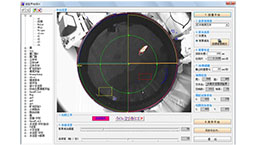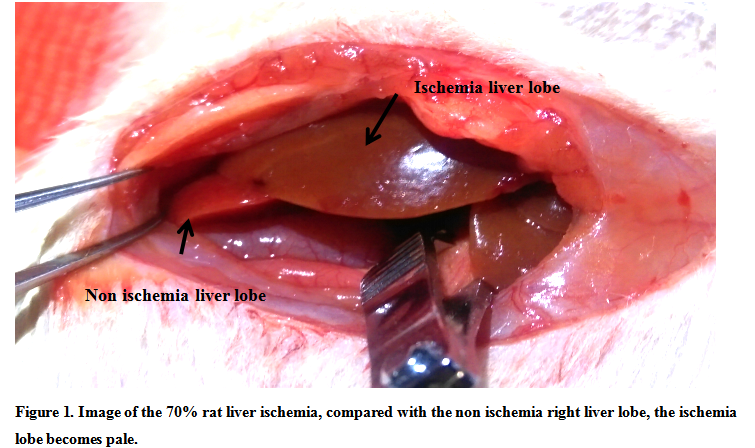Rat Model for Hepatic Ischemia (HI)
Hepatic ischemia/reperfusion; Liver ischemia
- Product No.DSI527Ra01
- Organism SpeciesRattus norvegicus (Rat) Same name, Different species.
- Prototype SpeciesHuman
- SourceIschemia and reperfusion
- Model Animal StrainsSD rats (SPF level), healthy, male, body weight 200g~220g.
- Modeling GroupingRandomly divided into groups: Control group, Model group, Positive drug group and Test drug group, 15 mice per group.
- Modeling Period24hrs, 72hrs
- Modeling Method1. Select 250g-300g Wistar rats, preoperative fasting, free drinking 12 hrs before operation.
2. 15% chloral hydrate 350mg/kg intraperitoneal injection anesthesia.Put the rat on the operating table and fix the limbs, and shave hair from abdomen to the xiphoid, disinfection with 10% iodine tincture and 75% ethanol.
3. Open the abdominal cavity, carefully separate the liver of the left and middle hepatic pedicle (left, middle lobe of the liver blood supply of the portal vein and hepatic artery).
4. Clip the middle lobe and left lobe of the portal vein and the hepatic artery, about 70% of the liver ischemia to prevent serious mesenteric venous congestion. 0.5min later, blocked leaves obviously become white colour, which indicates successfull blocking. Close the skin incision with hemostatic clamp and place the rats in 37 ℃ for constant temperature heating pad insulation.
5. Ischemia for 60mins, re-open the abdominal cavity, quickly remove the vascular clamp, restoring the ischemic liver blood flow, after about 0.5min, ischemic liver is gradually recovered to a bright red that indicates the successful reperfusion. Suture of abdominal muscles and skin, close the abdominal surgery. After waking up, put the rats back to the feeding room, keeping close attention to the status of the rats and make a record.
6. Reperfusion 0h, 3h, 6h, 12h, 24h and 72h , and kill rats, take 1mL blood, 4℃, 3000r for 10 mins to extract serum, stored at -80℃. Assay the levels of serum ALT (alanine aminotransferase) and AST (aspartate aminotransferase) by automatic biochemical analyzer.
Take the 0.2cm * 1cm * 1.5cm of the left lobe of liver to be used as pathological samples.
Important Note:
1. Separate the liver door with a cotton swab, avoiding the damage to the liver;
2. Preoperative fasting is conducive to surgery
3. Blocking blood flow must be successful in the first time, otherwise it will cause ischemic preconditioning, reduce the degree of injury;
4. After reperfusion, use a cotton swab to gently press the liver, it helps the blood flow recovery;
5. Don't damage the liver forceps. - ApplicationsDisease Model
- Downloadn/a
- UOM Each case
- FOB
US$ 240
For more details, please contact local distributors!
Model Evaluation
Liver ischemic injury score:
0 points: no liver cell damage
1 points: mild damage, characterized as cytoplasmic vacuoles, focal nuclear condensation
2 points: moderate damage, the expansion of the blood sinus, the vacuole of the cell, the cell boundary is fuzzy
3 points: moderate to severe damage, coagulation necrosis, a large number of blood sinus expansion, red blood cells to the liver lock, HE stained cells increased, neutral white blood cell edge (attached to the vascular wall)
4 points: severe necrosis, loss of liver structure, liver collapse, bleeding, neutrophil infiltration
Pathological Results
Take 1.5cm×1cm×0.2cm of the left lobe of the liver,fixed for 24h in 4% poly formaldehyde solution. HE staining and TUNEL staining were performed in paraffin sections. Serious damage to the structure of hepatic lobule, the reticular fiber scaffold collapse, liver cell necrosis, vacuolar changes, liver cell cord, liver sinus congestion and swelling, border is not clear, infiltration of inflammatory cells around them.
Cytokines Level
Assay the levels of ALT (alanine aminotransferase) and AST (aspartate aminotransferase) respectively at 0h、3h、6h, 24h, and 72h.
Statistical Analysis
SPSS software is used for statistical analysis, measurement data to mean ± standard deviation (x ±s), using t test and single factor analysis of variance for group comparison, P<0.05 indicates there was a significant difference, P<0.01 indicates there are very significant differences.
GIVEAWAYS
INCREMENT SERVICES
-
 Tissue/Sections Customized Service
Tissue/Sections Customized Service
-
 Serums Customized Service
Serums Customized Service
-
 Immunohistochemistry (IHC) Experiment Service
Immunohistochemistry (IHC) Experiment Service
-
 Small Animal Micro CT Imaging Experiment Service
Small Animal Micro CT Imaging Experiment Service
-
 Small Animal MRI Imaging Experiment Service
Small Animal MRI Imaging Experiment Service
-
 Small Animal Ultrasound Imaging Experiment Service
Small Animal Ultrasound Imaging Experiment Service
-
 Transmission Electron Microscopy (TEM) Experiment Service
Transmission Electron Microscopy (TEM) Experiment Service
-
 Scanning Electron Microscope (SEM) Experiment Service
Scanning Electron Microscope (SEM) Experiment Service
-
 Learning and Memory Behavioral Experiment Service
Learning and Memory Behavioral Experiment Service
-
 Anxiety and Depression Behavioral Experiment Service
Anxiety and Depression Behavioral Experiment Service
-
 Drug Addiction Behavioral Experiment Service
Drug Addiction Behavioral Experiment Service
-
 Pain Behavioral Experiment Service
Pain Behavioral Experiment Service
-
 Neuropsychiatric Disorder Behavioral Experiment Service
Neuropsychiatric Disorder Behavioral Experiment Service
-
 Fatigue Behavioral Experiment Service
Fatigue Behavioral Experiment Service
-
 Nitric Oxide Assay Kit (A012)
Nitric Oxide Assay Kit (A012)
-
 Nitric Oxide Assay Kit (A013-2)
Nitric Oxide Assay Kit (A013-2)
-
 Total Anti-Oxidative Capability Assay Kit(A015-2)
Total Anti-Oxidative Capability Assay Kit(A015-2)
-
 Total Anti-Oxidative Capability Assay Kit (A015-1)
Total Anti-Oxidative Capability Assay Kit (A015-1)
-
 Superoxide Dismutase Assay Kit
Superoxide Dismutase Assay Kit
-
 Fructose Assay Kit (A085)
Fructose Assay Kit (A085)
-
 Citric Acid Assay Kit (A128 )
Citric Acid Assay Kit (A128 )
-
 Catalase Assay Kit
Catalase Assay Kit
-
 Malondialdehyde Assay Kit
Malondialdehyde Assay Kit
-
 Glutathione S-Transferase Assay Kit
Glutathione S-Transferase Assay Kit
-
 Microscale Reduced Glutathione assay kit
Microscale Reduced Glutathione assay kit
-
 Glutathione Reductase Activity Coefficient Assay Kit
Glutathione Reductase Activity Coefficient Assay Kit
-
 Angiotensin Converting Enzyme Kit
Angiotensin Converting Enzyme Kit
-
 Glutathione Peroxidase (GSH-PX) Assay Kit
Glutathione Peroxidase (GSH-PX) Assay Kit
-
 Cloud-Clone Multiplex assay kits
Cloud-Clone Multiplex assay kits
| Catalog No. | Related products for research use of Rattus norvegicus (Rat) Organism species | Applications (RESEARCH USE ONLY!) |
| DSI527Ra01 | Rat Model for Hepatic Ischemia (HI) | Disease Model |






